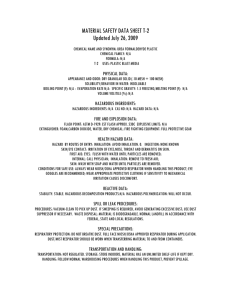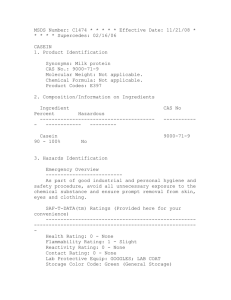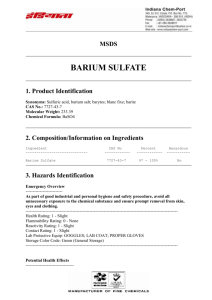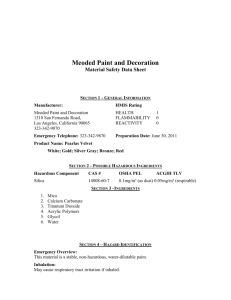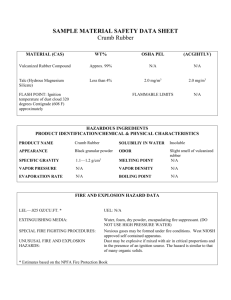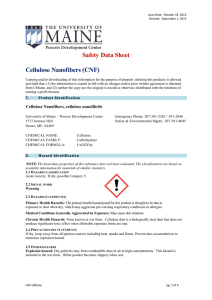CNC, aqueous suspension
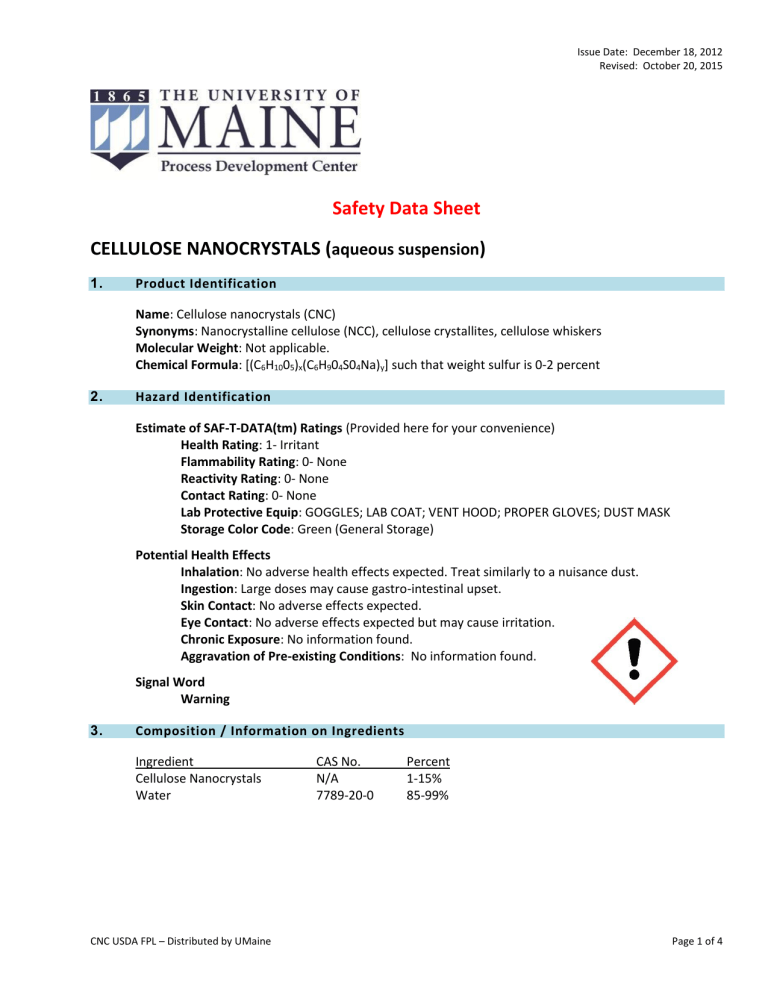
Issue Date: December 18, 2012
Revised: October 20, 2015
Safety Data Sheet
CELLULOSE NANOCRYSTALS (
aqueous suspension
)
1.
2.
3.
Product Identification
Name : Cellulose nanocrystals (CNC)
Synonyms : Nanocrystalline cellulose (NCC), cellulose crystallites, cellulose whiskers
Molecular Weight : Not applicable.
Chemical Formula : [(C
6
H
10
0
5
) x
(C
6
H
9
0
4
S0
4
Na) y
] such that weight sulfur is 0-2 percent
Hazard Identification
Estimate of SAF-T-DATA(tm) Ratings (Provided here for your convenience)
Health Rating : 1- Irritant
Flammability Rating : 0- None
Reactivity Rating : 0- None
Contact Rating : 0- None
Lab Protective Equip : GOGGLES; LAB COAT; VENT HOOD; PROPER GLOVES; DUST MASK
Storage Color Code : Green (General Storage)
Potential Health Effects
Inhalation : No adverse health effects expected. Treat similarly to a nuisance dust.
Ingestion : Large doses may cause gastro-intestinal upset.
Skin Contact : No adverse effects expected.
Eye Contact : No adverse effects expected but may cause irritation.
Chronic Exposure : No information found.
Aggravation of Pre-existing Conditions : No information found.
Signal Word
Warning
Composition / Information on Ingredients
Ingredient
Cellulose Nanocrystals
Water
CAS No.
N/A
7789-20-0
Percent
1-15%
85-99%
CNC USDA FPL – Distributed by UMaine Page 1 of 4
Issue Date: December 18, 2012
Revised: October 20, 2015
4.
5.
First Aid Measures
Inhalation : Remove to fresh air. Get medical attention for any breathing difficulty.
Ingestion : If large amounts were swallowed, give water to drink and get medical advice. May have laxative-like effects.
Skin Contact : Wash exposed area with soap and water. Get medical advice if irritation develops. Wash contaminated clothing before reusing.
Eye Contact : In case of contact, immediately flush eyes with plenty of water for at least 15 minutes, lifting upper and lower eyelids occasionally. Call a physician if irritation persists.
Fire Fighting Measures
Fire : As an aqueous suspension, the material will not burn. However, upon drying, as with most organic solids, ire is possible at elevated temperatures, contact with an ignition source or contact with strong oxidizers may cause fire.
Explosion : Fine mist dispersed in air may dry to dust, which in sufficient concentrations, and in the presence of an ignition source is a potential dust explosion hazard: For Cellulose: Minimum ignition temperature, dust cloud: 410C. Minimum explosible concentration: 0.045 g/1.
Fire Extinguishing Media : Water, dry chemical, foam or carbon dioxide. CAUTION: Pressure from the extinguishing media may cause severe dusting. Dispersed powder in air can create a severe explosion hazard.
Special Information : In the event of a fire, wear full protective clothing and NIOSH-approved self-contained breathing apparatus with full facepiece operated in the pressure demand or other positive pressure mode.
6. Accidental Release Measures
Turn off and disconnect electrical systems in the area to prevent electrical shock. Remove all sources of ignition. Ventilate area of leak or spill. Wear appropriate personal protective equipment as specified in
Section 8. Use appropriate tools to put the spilled material into a convenient waste disposal container.
Reduce airborne dust and prevent scattering by moistening with water. Finish cleaning by spreading water on the contaminated surface and dispose according to local and regional authority requirements.
7. Handling and Storage
Avoid mist formation and control electrical equipment and ignition sources. Employ grounding, venting and explosion relief provisions in accord with accepted engineering. Containers of this material may be hazardous when empty since they retain product residues (dust, solids); observe all warnings and precautions listed for the product.
8. Exposure Controls/Personal Protection
Airborne Exposure Limits : Not available
Ventilation System : A system of local and/or general exhaust is recommended to keep employee exposures as low as possible. Local exhaust ventilation is generally preferred because it can control the emissions of the contaminant at its source, preventing dispersion of it into the general work area. Please refer to the ACGIH document, Industrial Ventilation, A Manual of Recommended Practices, most recent edition, for details.
Personal Respirators (NIOSH Approved): If the exposure limit is exceeded and engineering controls are not feasible, a half facepiece particulate respirator (NIOSH type N95 or better filters) may be worn for up to ten times the exposure limit or the maximum use concentration specified by the appropriate
CNC USDA FPL – Distributed by UMaine Page 2 of 4
Issue Date: December 18, 2012
Revised: October 20, 2015
9. regulatory agency or respirator supplier, whichever is lowest.. A full-face piece particulate respirator
(NIOSH type N1OO filters) may be worn up to 50 times the exposure limit, or the maximum use concentration specified by the appropriate regulatory agency, or respirator supplier, whichever is lowest. If oil particles (e.g. lubricants, cutting fluids, glycerine, etc.) are present, use a NIOSH type R or P filter. For emergencies or instances where the exposure levels are not known, use a full-facepiece positive-pressure, air-supplied respirator. WARNING: Air- purifying respirators do not protect workers in oxygen-deficient atmospheres.
Skin Protection : Wear protective gloves and clean body-covering clothing.
Eye Protection : Use chemical safety goggles and/or full face shield where dusting or splashing of solutions is possible. Maintain eye wash fountain and quick-drench facilities in work area.
Physical and Chemical Properties
Appearance : Opaque viscous liquid.
Odor : Odorless.
Solubility : Colloidal suspension in water.
Bulk Density : 1g/cc pH : Approximately neutral as sodium form. As acid form pH near 2-3.
%Volatiles by volume@ 21C (70F) : No information found.
Boiling Point : No information found.
Melting Point : No information found.
Vapor Density (Air=1) : No information found.
Vapor Pressure (mm Hg) : No information found.
Evaporation Rate (BuAc=1) : No information found.
10. Stability and Reactivity
Stability : Stable under ordinary conditions of use and storage.
Hazardous Decomposition Products : Carbon dioxide and carbon monoxide may form when dried materials heated to decomposition.
Hazardous Polymerization : Will not occur.
Incompatibilities : Strong oxidizing agents.
Conditions to Avoid : Heat, flame, ignition sources, electrical equipment, misting, dusting, air, and incompatibles.
11. Toxicological Information
Not available.
12. Ecological Information
Environmental Fate: No information found.
Environmental Toxicity: No information found.
13. Disposal Considerations
Whatever cannot be saved for recovery or recycling should be managed in an appropriate and approved waste disposal facility. Processing, use or contamination of this product may change the waste management options. State and local disposal regulations may differ from federal disposal regulations.
Dispose of container and unused contents in accordance with federal, state and local requirements.
CNC USDA FPL – Distributed by UMaine Page 3 of 4
Issue Date: December 18, 2012
Revised: October 20, 2015
14. Transport Information
Mode: (Air, Land, water) Not regulated as a hazardous material by the U.S. Department of
Transportation. Not listed as a hazardous material in Canadian Transportation of Dangerous Goods
(TDG) regulations. Not listed as a Hazardous material for IATA and IMDG.
US DOT
Proper Shipping Name:
Hazard Class:
Not regulated
Not regulated
UN/NA ID Number:
Packing Group:
Label Required:
Not regulated
Not regulated
None required
15. Regulatory Information
US Federal Regulations
SARA Title III:
Sec 302/304 Extremely Hazardous Substance:
Sec 311 Hazardous Categorization:
Sec 313 Toxic Chemicals:
CERCLA Sec 102 (a) Hazardous Substance:
Not applicable
Not applicable
Not applicable
Not applicable
RCRA Information:
TSCA: All ingredients are on the TSCA inventory.
Not applicable
OSHA: Limits inhalation exposure of cellulose [29 CFR 1910.1000].
16. Other Information
NFPA Ratings : Health: 0 Flammability: 1Reactivity: 0 (estimated)
Label Hazard Warning : WARNING! AVOID MISTING, RESULTING POWDERED MATERIAL MAY FORM
EXPLOSIVE DUST-AIR MIXTURES. COMBUSTIBLE SOLID.
Label Precautions : Minimize dust dispersion and accumulation.
Keep away from electrical equipment, heat, sparks and flame.
Keep container closed.
Use only with adequate ventilation.
Label Firs Aid: Not applicable.
Product Use: Laboratory Reagent.
Revision Information: No Changes.
**********************************************************************************
Disclaimer : USDA FS Forest Products Laboratory provides the information contained herein in good faith but makes no representation as to its comprehensiveness or accuracy. This document is intended only as a guide to the appropriate precautionary handling of the material by a properly trained person using this product.
Individuals receiving the information must exercise their independent judgment in determining its appropriateness for a particular purpose. USDA FS FOREST PRODUCTS LABORATORY MAKES NO
REPRESENTATIONS OR WARRANTIES, EITHER EXPRESS OR IMPLIED, INCLUDING WITHOUT LIMITATION ANY
WARRANTIES OF MERCHANTABILITY, FITNESS FOR A PARTICULAR PURPOSE WITH RESPECT TO THE
INFORMATION SET FORTH HEREIN OR THE PRODUCT TO WHICH THE INFORMATION REFERS. ACCORDINGLY,
MALLINCKRODT BAKER, INC. WILL NOT BE RESPONSIBLE FOR DAMAGES RESULTING FROM USE OF OR RELIANCE
UPON THIS INFORMATION.
**********************************************************************************
Prepared by : USDA FS Forest Products Laboratory - Phone Number : (608) 231-9200 (U.S.A.)
Distributed by : The University of Maine, Process Development Center - Phone Number : (207) 581-2281
CNC USDA FPL – Distributed by UMaine Page 4 of 4
